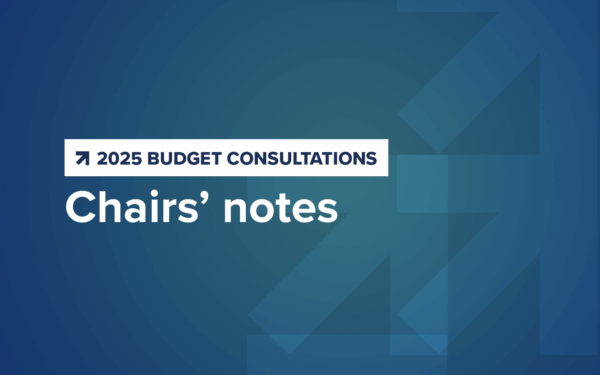The Federal Deficit: Some options for expenditure reduction
A Business Council on National Issues Discussion Paper
Summary
The Problem
The federal government has been running annual deficits in excess of $10 billion since the mid-1970s. The 1981-82 recession led to a sharp rise in the deficit to around $30 billion, and according to Department of Finance forecasts, the government will continue to run an annual deficit of at least $25 billion from now until fiscal year 1987-88. This pattern of continuously large federal deficits is leading to a very rapid increase in Canada’s total net federal debt. Federal government net fixed-value liabilities, which amounted to only 5.4 percent of GNP in 1975, equalled 24.6 percent of GNP in 1983 and are currently expected to exceed 36 percent of GNP by 1988. Particularly worrisome is the fact that large deficits and the rising debt-to-GNP ratio are expected to remain with us in spite of the optimistic economic growth forecasts contained in the last budget. Also disconcerting is the trend toward an ever-rising share of federal revenues being required simply to service Canada’s growing debt. At present, for example, almost one tax dollar in three is needed to service the federal debt, and this figure, too, is expected to remain high over the next several years.
A minority view in the economic community, principally espoused by academic economists, is that deficits do not matter much and that our political leadership should not hesitate to expand the deficit significantly in order to stimulate economic growth. We do not share this view, and our political leaders would be wise to reject it as well. The fact is that Canada’s persistently high deficits and mushrooming debt left unchecked will lead inevitably to a combination of economic problems that could include:
- rising interest rates;
- the crowding out of private investment, and the consequent reduction of the country’s capital stock;
- growing fear that the government will resort to inflationary finance to finance the deficit (especially given the huge interest payments required to service the national debt);
- the growth of foreign indebtedness through foreign borrowing to raise capital unavailable domestically because of the size of public sector borrowing;
- reduced scope for future stabilization policy initiatives by the federal government because of the enormous burden of interest charges on the rapidly accumulating debt and the mounting concern over persistently large deficits even during times of economic growth.
The need for action: a strategy for expenditure reduction and reallocation
There are only two ways to lower the deficits projected over the next several years – – tax increases, or expenditure cuts. Initially, efforts should be concentrated on the expenditure side of the budget equation. Expenditure reductions, in contrast to tax increases, actually free up real resources in the economy that can be utilized by the private sector for the expansion of productive capacity. Significantly, spending reductions do not have the same adverse impact on the incentive to work, save and invest as do tax increases. In an effort to encourage the federal government to confront the deficit challenge, to examine its manifold spending commitments, and to make the hard choices required, the Business Council has prepared a policy paper that seeks to assess the scope for spending reductions and reallocations by examining current federal spending commitments on an envelope-by-envelope basis. This investigation has identified areas where substantial savings, between $5-10 billion per year, can be made. The monies obtained by reducing these programs and expenditures would then be available to the federal government both for essential policy initiatives in priority areas (e.g. youth unemployment) and for deficit reduction, although we believe that priority must be given to the latter. A credible schedule for debt reduction should also be a goal of such a strategy.
Will such a strategy lead to some adverse economic consequences in the short term? Yes, it will. The reductions of the magnitude we are proposing will affect many Canadians who are beneficiaries of public largesse – – among them many of the member companies of the Business Council. But, in our view the short term consequences will not be significant and they will be borne by Canadians who are able to make the sacrifices necessary. The poor and the disadvantaged must not in any way be victimized as we return collectively to a position of fiscal integrity.
Expenditure reductions by envelope
Our research indicates that many programs m the Fconomic Development envelope are actually detrimental to the country’s economic development because they introduce needless distortions and inefficiencies into the national economy. Some of the $ l 1.2 billion that will be spent from this envelope in fiscal year 1984–85 consists of subsidies to agriculture and for various modes of transportation, especially passenger rail transportation. There is no economic justification for continuing to subsidize these activities to such an extent; considerable savings are possible through reducing some subsidies, capping others, and raising user charges to increase revenues. Other programs in this envelope that should be cut significantly are those for industrial and regional development, budgeted at some $ l billion for 1981/-85. There is little evidence to suggest that these grants are needed to support viable business and investment activity. Nor is it clear that public servants in Ottawa are well placed to ascertain the merits of business investment proposals.
The Energy envelope llkewise contains a plethora of programs that do not deserve high priority and thus could be reduced. Petroleum Incentive Payments should be phased out as soon as practicable. In light of falling oil prices and the existence of market incentives, both the Canadian Horne Insulation Program (CHIP) and the Canadian Oil Substitution Program (together budgetted at over $370 million in 1984-85) appear unnecessarily large and expensive. Planned equity injections of $425 million into PetroCanada in 1981/-85 could also be substantially reduced. Atomic Energy of Canada Limited’s planned budget of $331 million offers another area for potential savings; AECL’s heavy water plants, which produce a product for which there is no evident demand, should be a particular focus of attention in this regard.
The Social Affairs envelope is budgetted at almost $40 billion in 1981/- 85 and represents more than half of all government program outlays. The Business Council has long argued that ways must be found to target Canada’s generous social programs more effectively, so that those Canadians who require income transfers and other forms of assistance continue to receive them while those who are better off receive less. Adoption of a more selective philosophy in respect of Family Benefits could save approximately $1-2 billion annually, depending on the approach used to determine eligibility. The Old Age Security program is another universal income transfer that could be changed by introducing a greater measure of selectivity. As a start, consideration could be given to de-indexing the universal OAS and enriching the income tested Guaranteed Income Supplement (GIS). Together, OAS, GIS and the Spouse’s Allowance will cost $11 .3 billion in 1981/-85, so even modest modifications in this area could yield substantial savings.
Another important program in the Social Affairs envelope is Established Programs Financing (EPF), budgetted at $5.6 billion in 1981/-85. The present EPF Act does not expire until March 1987, but at that time it should be possible to reduce federal outlays by several hundred million dollars, particularly in light of the fact that Ottawa is now paying a disproportionate share of the cost of post-secondary education in several provinces. Roughly $1 billion is being spent through this envelope in 1984-85 by CMHC on social housing. CMHC’s own studies indicate that many of those who receive the benefits of its housing programs do not require such assistance; thus, significant cuts could be made in this program without hurting low-income Canadians. Additional expenditures in the Social Affairs envelope that could be reduced as part of a broad strategy of deficit reduction are the CBC (almost $900 million in 1981/-85), the National Film Board ($62.5 million), and the Canadian Film Development Corporation ($51/.8 million). In addition, critical examination of the Canada Employment and Immigration Commission’s direct job-creation programs indicates that many of these do not provide effective employment experience or opportunities. As soon as the unemployment situation eases, these programs should be scaled back.
Over $2.7 billion will be spent in fiscal 1981/-85 through the External Affairs and Aid envelope, the vast majority on Official Development Assistance (ODA). The February 1981/ budget indicates that ODA is planned to rise very rapidly over the next few years as a share of Canada’s GNP. In view of pressing domestic economic priorities and the need to lower the deficit, these planned increases should be· scaled back. lf ODA were held at its current level of GNP, savings of almost $500 million per year would result by fiscal year 1987-88; if, instead, ODA were frozen at its 1983-84- real level, then savings of some $280 million would be realized in fiscal year 1985-86, rising to almost $825 million by fiscal year 1987-88.
With respect to Government Overhead expenses, it is expected that some $8.8 billion will be spent in 1984–85 on non-defence salaries, wages and other personnel costs, and another $6.4- billion on other non-defence operating expenditures. Total non-defence authorized personnel years will be over 223,000 in 1984-85. A very modest 2 percent cut in personnel years and nondefence wages, salaries and other operating expenditures would result in a saving of over $300 million in the 1984-85 fiscal year; in the case of a 4 percent cut, the savings would be over $600 million. Larger savings would be realized in subsequent years in comparison with what is expected in the present Fiscal Plan. This is clearly another area where savings can be achieved.
With respect to Government Overhead expenses, it is expected that some $8.8 billion will be spent in 1984–85 on non-defence salaries, wages and other personnel costs, and another $6.4- billion on other non-defence operating expenditures. Total non-defence authorized personnel years will be over 223,000 in 1984-85. A very modest 2 percent cut in personnel years and nondefence wages, salaries and other operating expenditures would result in a saving of over $300 million in the 1984-85 fiscal year; in the case of a 4 percent cut, the savings would be over $600 million. Larger savings would be realized in subsequent years in comparison with what is expected in the present Fiscal Plan. This is clearly another area where savings can be achieved.
The options
Our examination of the scope for federal spending reductions led to the development of three options or “packages” of expenditure cuts. Options one and two aim for spending reductions of $2.5 billion in the remainder of fiscal 1984-85, rising to $6 billion per year by 1987-88. Option one targets the Economic Development envelope for relatively heavy cuts. Option two suggests larger cuts in the Social Affairs envelope. In addition to these program and spending cuts, account would have to be taken of the reduced public debt servicing charges that result from options one and two. When these are included, total spending cuts rise to $2.6 billion in 1984-85, and to $7.6 billion for fiscal year 1987-88.
Option three envisages larger spending reductions: $3.2 billion in the remainder of fiscal 1984-85, rising to an annual cut of $8.6 billion by 1987-88. Again, the reduced public debt charges that result from these cuts in spending raise these two figures to $3.3 billion and $10.8 billion, respectively. It should be noted that in the case of option three, spending reductions of $10.8 billion in fiscal 19 87-88 should be viewed in relation to expected total federal spending in that year, which the February 1984 budget estimates will be $115 billion. The tables at the end of this study summarize the three options for spending reductions contemplated by the BCNJ on an envelope basis.
Conclusion
Continued, rapid deterioration in the state of public finances in Canada makes deficit reduction an urgent priority over the next several years. The sharp rise in the debt-to-GNP ratio now forecast to occur in the last half of the decade needs to be moderated. The view held by some, that by increasing the already huge deficit the federal government can succeed in boosting growth and cutting the unemployment rate in Canada, is simply not borne out by the facts. The massive Canadian deficits recorded since 198 1, amounting to 5-7 percent of GNP, demonstrably have failed to generate needed jobs, while in the United States, which has total public sector deficits far smaller than Canada’s on a per capita basis, unemployment has been declining rapidly and economic growth remains buoyant.
We are of the view that further expansion of the deficit and growth in the ballooning national debt will be detrimental to the Canadian economy and that the temptation to move in this direction must be strongly resisted. Instead, what is required is a clear political commitment at the Prime Ministerial level to begin the painful process of reducing the federal government’s spending and program commitments as a key priority in the autumn of 1984-.









